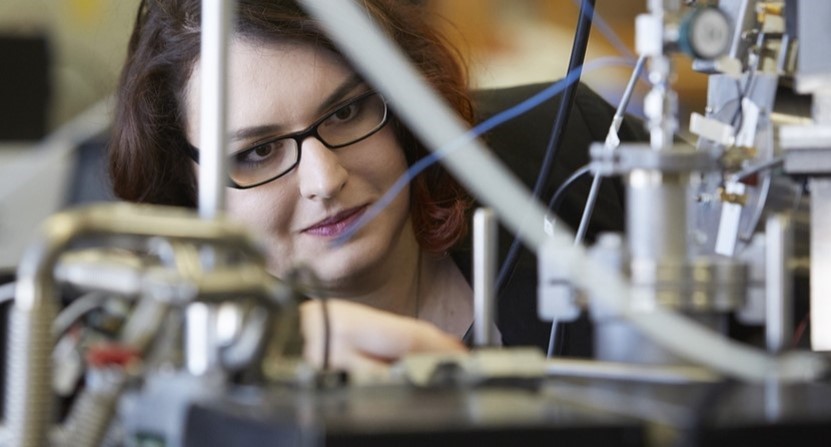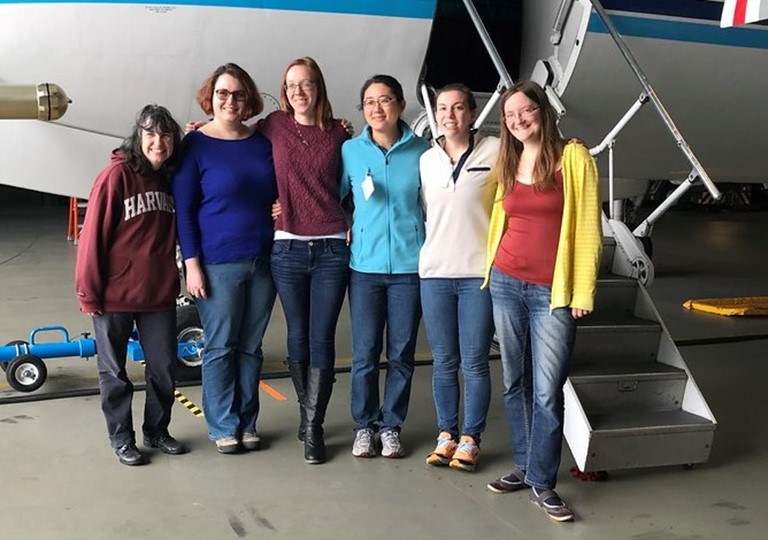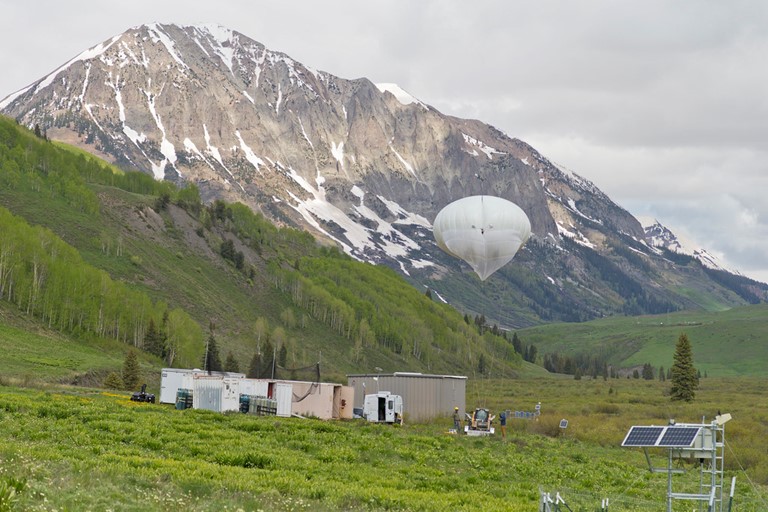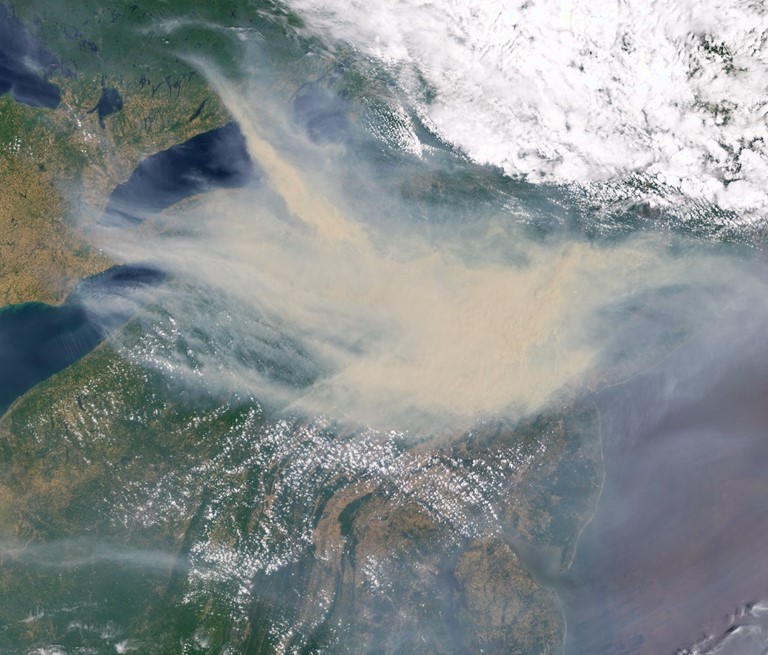
A Brookhaven National Laboratory atmospheric chemist takes on a new role in the American Association for Aerosol Research’s instrumentation working group
Regarding aerosols, you might ask: Why do such little particles play such a big role in the atmosphere?
Maria Zawadowicz (za-WAD-o-wits), an assistant environmental scientist at Brookhaven National Laboratory (BNL), is ready with an answer. To her science-challenged friends she would say that these hybrid particles of liquid, solids, and gases, some barely larger than a strand of DNA, make cloud formation possible.
From there, decks of clouds—sometimes hundreds of miles wide—influence how much solar radiation reaches the surface of the Earth. Their variable warming and cooling effect on oceans and land masses mean that clouds (and the aerosols that seed them) are important to study.
“I study very small microphysical processes on this very minute scale,” says Zawadowicz. “But they, in turn, influence very large cloud systems so large they can be seen from space.”
In part, her study of aerosols is reflected in an ongoing project sponsored by the Atmospheric System Research (ASR) program at the U.S. Department of Energy (DOE): the Process-level AdvancementS of Climate through Cloud and Aerosol Lifecycle Studies (PASCCALS) Science Focus Area, for which Zawadowicz is a co-investigator.
PASCCALS is investigating the multi-faceted magnitude of how aerosols and clouds influence the Earth’s energy budget: how much solar radiation reaches the surface, a question in line with ASR’s mission to support research that improves climate models. The PASCCALS investigation requires deep dives into cloud condensation nuclei, aerosols linked to biomass burning, cloud processes in the atmospheric boundary layer, and the microphysics of clouds that create storms.
PASCCALS also has a fifth theme: to study the interaction of aerosols and convective (storm) clouds during the TRACER field campaign. The name stands for the Tracking Aerosol Convection Interactions Experiment (TRACER), a 2021─2022 field campaign in the Houston, Texas area. Her PASCCALS research centers primarily on analyzing TRACER aerosol data.
An AAAR Honor
“Maria is one of the most enthusiastic early-career researchers I have had the pleasure to work with,” says BNL’s Mike Jensen, TRACER lead scientist and one of four principal investigators for the ASR project. “For PASCCALS, she brings her particular expertise in atmospheric chemistry and the measurement and analysis of the chemical composition of aerosol particles both in the laboratory and during field campaigns.”
Praise arrived recently for Zawadowicz from another source. In October 2023, she was named vice chair of the instrumentation working group at the American Association for Aerosol Research (AAAR).
After a one-year term, she will assume the role of the group’s chair.
AAAR was founded in 1982 to address the growing realization that aerosols are essential to understanding the complex vastness of the atmosphere and the fate of particles that affect human health.
Working groups help organize the AAAR’s annual meetings by providing suggestions on tutorials, plenary speakers, session topics, and special symposia.
The yearly meetings draw hundreds of scientists from all over the world. Their research spans the kind of aerosols Zawadowicz studies—as well as those emitted by car tires, chicken coops, sneezes, ship plumes, and biomass burning.
Traveling for Work

At BNL, Zawadowicz designs and makes aerosol field instruments. Some of them use on-site mass spectrometry to analyze the chemistry of aerosols.
She is also the lead instrument mentor for the Aerosol Chemical Speciation Monitor for the Atmospheric Radiation Measurement (ARM) user facility at DOE’s Office of Science.
ARM operates six atmospheric observatories in climate-critical regions of the world: three are in fixed locations; three are mobile—in place anywhere from six months to five years.
From 2017 to 2023, Zawadowicz took part in three ARM campaigns in addition to TRACER. Her first was in the Azores: Aerosol and Cloud Experiments in the Eastern North Atlantic (ACE-ENA), including what she called the thrill of airborne research.
“I love field work. It’s the sort of real-world component that is very satisfying. We study the environment. You can’t just do that in a lab.”
– Maria Zawadowicz
After TRACER came a 21-month ARM field campaign in the Rocky Mountains called the Surface Atmosphere Integrated Field Laboratory (SAIL). Zawadowicz received Fiscal Year 2023 FICUS funding from the DOE to analyze SAIL vertical profiles of the atmosphere collected by ARM tethered balloon systems (TBS). (FICUS stands for Facilities Integrating Collaborations for User Science.)
Zawadowicz’s most recent fieldwork took place along the ocean shoreline of southern California during the Eastern Pacific Cloud Aerosol Precipitation Experiment (EPCAPE), which wraps up in February 2024.
“In general,” says Zawadowicz, “I’m really interested in utilizing data from ARM campaigns.”
For most campaigns, she is on site to set up aerosol instruments, returns to calibrate them periodically, and then takes them down to recalibrate again. In between, Zawadowicz and her team back at BNL monitor the instruments’ performance remotely.
“I love field work,” says Zawadowicz. “It’s the sort of real-world component that is very satisfying. We study the environment. You can’t just do that in a lab.”
Wildfires, Thunderstorms, and an Aerobiome
During AAAR’s 41st annual conference, Zawadowicz dove into the melee of hundreds of presentations and posters, highlighting three projects of her own.

One project is in collaboration with atmospheric chemist John Shilling at Pacific Northwest National Laboratory (PNNL) to investigate gases that arise from wildfires and become aerosols. The researchers use an environmental chamber at PNNL to study two representative classes of these gases, along with the properties of the aerosols they form.
Zawadowicz also presented a poster related to her aerosol-characterization work during TRACER. Part of the campaign’s science mission was to study how these tiny particles influence storm initiation and convective cloud life cycles. Zawadowicz was responsible for aerosol chemistry measurements at TRACER’s main and auxiliary sites.
At the AAAR conference, she also shared a few initial results from her study of the “aerobiome” present during SAIL. An aerobiome is the collective microscopic life in a particular air space, including fungi, bacteria, viruses, pollen grains, and other bits of organic matter.
Zawadowicz and her collaborators, using space on TBS, deployed instruments designed to measure particle fluorescence. When excited by a laser, how much light particles give off is a proxy for biological material in the atmosphere.
Curiosity, Crossed with Nature
“I was always pretty curious” and loved the natural world, says Zawadowicz, who remembers frequent early childhood hikes in her native Poland.
Later, growing up in suburban Chicago, she kept her interest in the natural world, including the charms of Lake Michigan.

As an undergraduate at nearby Lake Forest College (B.A., Chemistry and Physics, 2012), Zawadowicz joined the lab of atmospheric chemist Lori Del Negro, an enthusiastic veteran of fieldwork. Lake Forest, says Zawadowicz, is where her dreams, aspirations, and interests fell into place.
In the Del Negro lab, students built small devices to sample air toxins. An interest in designing, making, and running instruments followed Zawadowicz to the Massachusetts Institute of Technology (PhD, Atmospheric Chemistry, 2017).
Zawadowicz joined MIT’s Program in Atmospheres, Oceans and Climate, directed by Professor of Atmospheric Chemistry Dan Cziczo, where she devised a way to differentiate bioaerosols in the atmosphere from inorganic particulates like dust.
Her breakthrough 2017 paper established that bioaerosols are 25 to 50 times more rare than previous estimates. Her methods were part mathematics (a machine learning algorithm) and part machine (a single particle mass spectrometer).
As a postdoctoral researcher at PNNL (2017-2020), Zawadowicz spent most of her time at the Atmospheric Measurements Laboratory, a facility where instrumentation dominates the workload. It is home to the environmental chamber she is using with PNNL’s Shilling for the wildfire aerosol work she presented at the October 2023 AAAR meeting.
Today, at BNL, Zawadowicz knows every nut, bolt, stack, and dial of the ARM Aerosol Observing System (AOS).
The AOS includes her workhorse instrument, the aerosol chemical speciation monitor (ACSM). It allows her to study what is small (aerosols), which influences what is so large (fields of clouds that can be seen from space).
Says Zawadowicz: “Our work makes an impact across scales.”
# # #Author: Corydon Ireland, Staff Writer, Pacific Northwest National Laboratory
This work was supported by the U.S. Department of Energy’s Office of Science, through the Biological and Environmental Research program as part of the Atmospheric System Research program.

